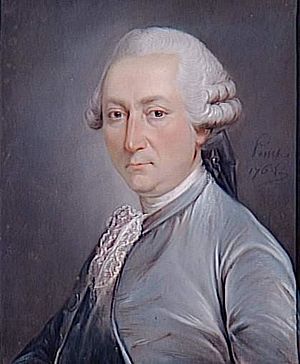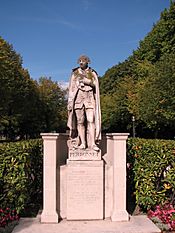Jean-Rodolphe Perronet facts for kids
Quick facts for kids
Jean-Rodolphe Perronet
|
|
|---|---|

Jean-Rodolphe Perronet
|
|
| Born | 27 October 1708 |
| Died | 27 February 1794 (aged 85) |
| Nationality | French |
| Occupation | Engineer |
| Engineering career | |
| Projects | Pont de la Concorde |
| Significant advance | arch bridges |
Jean-Rodolphe Perronet (born October 27, 1708 – died February 27, 1794) was a famous French engineer and architect. He was especially known for building many stone arch bridges. His most famous work is the Pont de la Concorde bridge in Paris, which he finished in 1787.
Early Life and Training
Jean-Rodolphe Perronet was born in Suresnes, a town near Paris, France. His father was a guard from Switzerland.
When he was 17, Perronet started working as an apprentice for Jean Beausire. Beausire was the main architect for the city of Paris. Perronet learned a lot there. He helped design and build big projects like Paris's sewer system and riverbanks. He also helped maintain the roads around the city.
In 1735, he became an assistant engineer in a region called Alençon. The next year, he joined the group in charge of bridges and roads in France. By 1737, he was promoted to engineer for the généralité (a type of region) of Alençon.
A Career Building Bridges and Minds
In 1747, Perronet became the director of the Royal Office of Designers. This office was also responsible for making maps and plans for the entire kingdom. This was the start of what would become the famous École des ponts et chaussées. This school trained engineers to build bridges and roads.
Perronet was like a mentor and teacher to his students. He used new ways of teaching that are still used today. During this time, he became friends with Charles Labelye, another bridge builder from Switzerland.
In 1763, Perronet was named the "first engineer to the king." Two years later, he became a member of the Academy of Sciences.
Besides his amazing bridges, Perronet also oversaw the building or repair of over 2,500 kilometers (about 1,550 miles) of roads between 1747 and 1791. He even wrote an article about "fire-engines" for the famous Encyclopédie.
In 1772, Perronet was chosen as a foreign member of the Royal Swedish Academy of Sciences. He also became a Fellow of the Royal Society in 1788.
Legacy and Famous Works
Jean-Rodolphe Perronet passed away in Paris on February 27, 1794, when he was 85 years old.
Today, a street in Paris is named after him. You can also find a statue of him on the Île de Puteaux, near the Pont de Neuilly. Perronet built the first version of this bridge in 1772.
He designed and built many important bridges across France. His work helped improve travel and trade.
Here are some of the bridges Perronet worked on:
- 1750–1760 – Bridge at Orléans
- 1757–1765 – Bridge at Mantes
- 1758–1764 – Bridge at Trilport
- 1765–1786 – Bridge at Château-Thierry
- 1766–1769 – Pont Saint-Edne at Nogent
- 1768–1774 – Bridge at Neuilly-sur-Seine
- 1770–1771 – Pont Les Fontaines
- 1774–1785 – Bridge at Sainte-Maxence sur l'Oise
- 1775 – Bridge at Biais-Bicheret
- 1776–1791 – Bridge at Nemours
- 1776- – Bridge at Mirepoix, Ariege
- 1784–1787 – Bridge at Brunoy
- 1786–1787 – Bridge at Rosoy
- 1786–1791 – Pont Louis XVI, later renamed Pont de la Concorde, Paris




